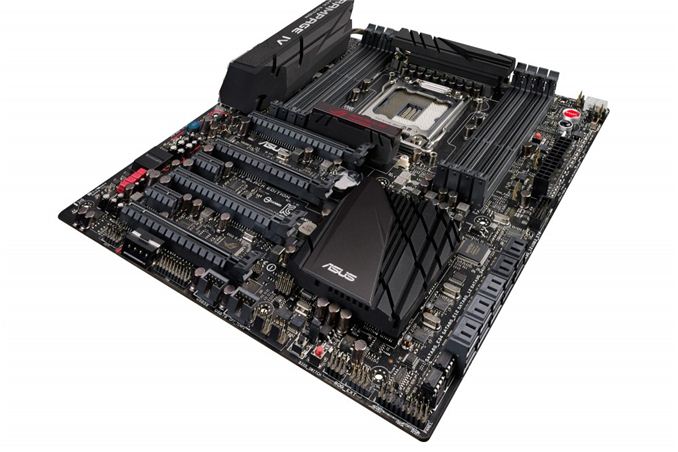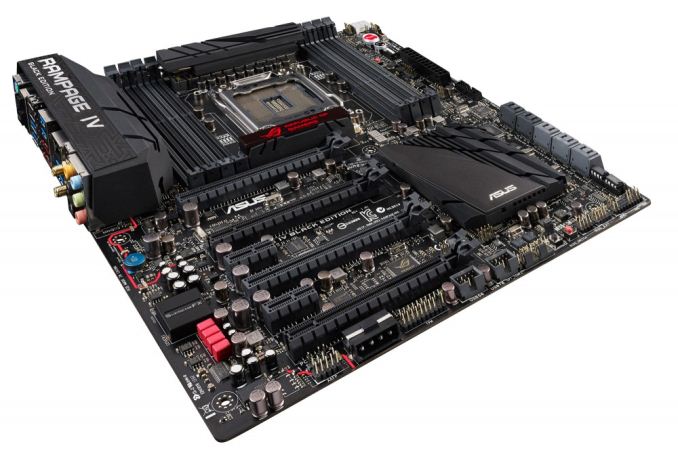ASUS Announces Rampage IV Black Edition, Coming 11/19
by Ian Cutress on November 8, 2013 7:50 AM EST- Posted in
- Motherboards
- Asus
- X79
- ROG

The extreme end of Intel’s performance platform is a relatively small end-user market, but despite this we had requests back at Sandy Bridge-E launch to test a good number of X79 motherboards due to the large and differing array of available features on offer. Our best of the bunch was the ASUS Rampage IV Extreme, part of the ROG range and received my best ever award given to a motherboard (which is actually our second highest award at AnandTech - my standards are that high that I doubt anyone will ever achieve the top award and I'm not entirely sure what would qualify, until I saw it).
When Ivy Bridge-E rolled around, I expected an uptake on the motherboard side to incorporate many of the new features Z77 and Z87 development had brought to the game, despite the age of the chipset holding the ecosystem back somewhat (no native USB 3, limited native SATA 6 Gbps). What happened at Ivy Bridge-E launch was almost a non-starter: very few motherboard manufacturers announced updates, most of them delayed, and some decided not to bother even updating the BIOS on old boards to support the new processors.
There are a few new X79 motherboards I would like to test while the platform is still alive, and one of them is the new ASUS Rampage IV Black Edition, officially announced for an 11/18 launch. ASUS had teased a Rampage IV Extreme in black on the forums for several months, but this is designed to be a wholly new board in the spectrum above the Extreme.

The first point to notice, aside from the black livery, is that a large number of overclocking features have followed the way of the Z87 Maximus VI Extreme and are moved onto an OC Panel. This is the same OC Panel as the M6E, albeit updated for X79 and supporting VGA Hotwire, SubZero Sense, Pause Switch, dynamic overclocking, fan headers etc. ASUS have used 60A VRMs and chokes for high quality power delivery to an overclocked CPU.
The RIVBE also features an updated sound system, taking cues from the SupremeFX range on Z87 to become SupremeFX Black with ELNA audio caps, WIMA film caps and a Cirrus Logic CS4398 DAC for a 120dB signal-to-noise ratio. This works in turn with Sonic Radar, a feature designed to help gamers determine noise location with an on-screen visual sound map. Software-wise the motherboard also comes with the new ROG RAMDisk, GameFirst II, and Secure Erase.
Other hardware on the motherboard includes a dual band 802.11ac / BT 4.0 WiFi solution, an Intel GbE NIC, eight USB 3.0 (six on rear), two eSATA 6 Gbps, support for four-way SLI and Crossfire, four SATA 6 Gbps (and six SATA 3 Gbps). The only issue I can see with the motherboard that I might disagree with is the use of a 4-pin molex for additional PCIe power rather than a 6-pin PCIe.
The Rampage IV Black Edition is set to retail at US$499, compared to $430 for the Rampage IV Extreme. This is indeed a lot of money for a motherboard – we are hoping to get one in before launch to see if it can build on the success of the RIVE.














15 Comments
View All Comments
TEAMSWITCHER - Friday, November 8, 2013 - link
It's a great looking motherboard and I would love to build a new system with one, but....I can imagine the terrible feeling I'd have next year once the 8-core Haswell-E X99 motherboards hit the streets. If there was ever a time to exercise a little patience....it's now.
odwillia - Friday, November 8, 2013 - link
I agree....waiting for Haswell-E. Nice motherboard though tempting...tw33k - Friday, November 8, 2013 - link
The urge to order one of these is becoming harder to resist. I'd love to bench this with a 4930K. There's always going to something new and improved "just around the corner" so when is a good time to buy?dragonsqrrl - Friday, November 8, 2013 - link
When you're not nearing the end of a platforms life cycle? Especially one that was feature gimped to begin with.I think this argument is even stronger for Intel's enthusiast/prosumer platforms (X58, X79, X99) that typically have much longer lifespans than its mainstream platforms.
ShieTar - Friday, November 8, 2013 - link
Can anybody explain to me how to operate the release lever for the first PCIe slot with a dual or triple-slot GPU installed? It's hard enough with most CPU-coolers installed, but with this badly placed cooler-block on this board it looks to be rather impossible.IanCutress - Friday, November 8, 2013 - link
Systems that have a heatsink in the way like this (there are a few), I basically end up using a screwdriver or a pen in the gap, making sure I don't slip and damage something on the motherboard. Perhaps use the eraser end of a pencil.LauRoman - Friday, November 8, 2013 - link
I have seen boards that instead of having just a pull pin on the "underside" (the side that has gpu and heatsink etc) which will be hard to reach for a double or triple slot gpu, it alsp has a pull pin on the other side too. But for a >=2 long(ish) pcb card setup that would be hard to use too. http://www.gigabyte.com/fileupload/product/2/2500/...DanNeely - Friday, November 8, 2013 - link
Looking at additional images of the board on Newegg; it appears that board just has a slightly wider version of the old single side release mechanism that has been replaced by the one on this ASUS board because they were all but impossible to release with 2 slot cards. The heatsink placement on this board will make pressing it with a finger difficult at best; but pushing strait down with a plastic spatula or the eraser end of a pencil should be much easier than trying to maneuver something under the card to hit a side latch.1Angelreloaded - Friday, November 8, 2013 - link
Nice board but not worth buying, always was an Asus fan since the original Crosshair/Striker Extreme boards came out. There is no point in this whatsoever, the fact it does not natively support USB 3.0 and Sata 3 means the board is at a serious disadvantage from the get go let alone the next gen is right over the hill. There is just no point in investing in a dying platform, unless intel would have revamped the chipsets and allowed newer revisions of the motherboard to be equal with the Z87 platform.ASUSTechMKT - Friday, November 8, 2013 - link
X79 does not offer USB 3.0 via a native controller but it is provided via an add on controller. The controller used is actually the latest ASMedia 1042A which is XHCI 1.0 compatible meaning it requires no drivers under Windows 8 and offers the benefit over the native Intel controller of offering UASP performance under Windows 7 and WIndows 8. Additionally SATA6G is native to the SATA controller for X79. 2 Ports in addition there are supplemental controllers. Hopes this clarifies things for you.